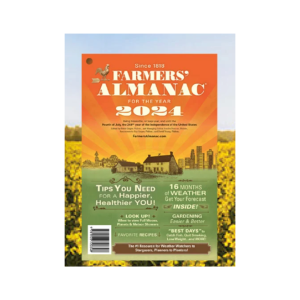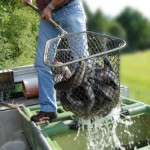 And let’s clear up the confusion
And let’s clear up the confusion
The Old Farmer’s Almanac, originally the Farmer’s Almanac with the “Old” being officially added in 1848, not to be confused with the Farmers’ Almanac, has been in publication since 1792, making it the longest-running publication in North America.
The Old Farmer’s Almanac was started by Robert B. Thomas in the vein of Benjamin Franklin’s Poor Richard’s Almanack. With a focus on weather predictions, the methods developed by Thomas – studying solar activity and astronomy – were later developed into a secret forecasting formula that is still used today. In fact, Thomas’ research and formula are kept in a black box in the Almanac offices in Dublin, New Hampshire.
But what’s with the hole? Robert B. Thomas drilled a hole in the top left corner of the almanac so subscribers could hang the book by a nail or a string.
How accurate are the predictions?
The Old Farmer’s Almanac touts 50.7% accuracy when it comes to temperature forecasts and 51.9% precipitation forecasts.
Though those numbers are midline, a lot of stock is put in the accuracy of the Old Farmer’s Almanac. In fact, Abraham Lincoln, a defense attorney at the time, used the almanac to defend a client, refuting the testimony of an eyewitness who claimed to see the defendant by the light of the full moon. Impossible, according to the Old Farmer’s Almanac; the moon was but a sliver in the sky on the night in question.
But was it the Old Farmer’s Almanac?
Well, maybe not. Because the original book was not preserved – there was no way anyone (not even the Old Farmer’s Almanac) could predict that the young lawyer using the book as evidence would go on to become the 16th President of the United States and an all-around big deal.
The Farmers’ Almanac – yep, the other guy – claims it was their book Lincoln used to defend his client.
Speaking of the Farmers’ Almanac, it has been in continuous publication since 1818. Published in Lewiston, Maine, the Farmers’ Almanac focuses on long-range weather predictions, calendars, moon phases, folklore, and natural remedies.
Like the Old Farmer’s Almanac, the Farmers’ Almanac uses an “exclusive mathematical and astronomical formula that relies on sunspot activity, tidal action, planetary position, and many other factors”.
Unlike the Old Farmers’ Almanac, the accuracy runs around 85%, which is higher even than Punxsutawney Phil. In fact, their forecasts are published under the pseudonym Caleb Weatherbee to protect their identity and to keep them from getting badgered in public.
Ryanne Harper



